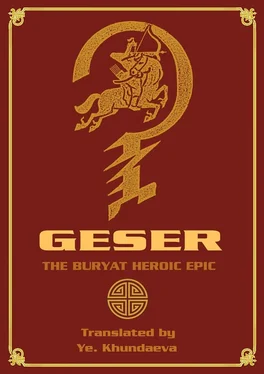Ye. Khundaeva - Geser. The Вuryat heroic epic
Здесь есть возможность читать онлайн «Ye. Khundaeva - Geser. The Вuryat heroic epic» — ознакомительный отрывок электронной книги совершенно бесплатно, а после прочтения отрывка купить полную версию. В некоторых случаях можно слушать аудио, скачать через торрент в формате fb2 и присутствует краткое содержание. ISBN: , Жанр: Языкознание, foreign_language, на английском языке. Описание произведения, (предисловие) а так же отзывы посетителей доступны на портале библиотеки ЛибКат.
- Название:Geser. The Вuryat heroic epic
- Автор:
- Жанр:
- Год:неизвестен
- ISBN:9785448558627
- Рейтинг книги:3 / 5. Голосов: 1
-
Избранное:Добавить в избранное
- Отзывы:
-
Ваша оценка:
- 60
- 1
- 2
- 3
- 4
- 5
Geser. The Вuryat heroic epic: краткое содержание, описание и аннотация
Предлагаем к чтению аннотацию, описание, краткое содержание или предисловие (зависит от того, что написал сам автор книги «Geser. The Вuryat heroic epic»). Если вы не нашли необходимую информацию о книге — напишите в комментариях, мы постараемся отыскать её.
Geser. The Вuryat heroic epic — читать онлайн ознакомительный отрывок
Ниже представлен текст книги, разбитый по страницам. Система сохранения места последней прочитанной страницы, позволяет с удобством читать онлайн бесплатно книгу «Geser. The Вuryat heroic epic», без необходимости каждый раз заново искать на чём Вы остановились. Поставьте закладку, и сможете в любой момент перейти на страницу, на которой закончили чтение.
Интервал:
Закладка:
Widely spread were the genealogical myths in which the cult of the mountain spirits was depicted. It is just the mountain spirit who appears to be in fact the father of Geser on the Earth. According to the epic the man possesses not one soul but a few of them. One soul is in the body, another one may leave the body in its sleep, the other souls are somewhere else out of body. Very often the souls are of the zoomorphic form like the two golden fish coming out of a mangus’ nostrils during his sleep. One might recollect the hero chasing the three stags that were said to keep inside the soul of a mangus. In the Oirat epic the soul may be found in a copper-headed iron-winged crow which flies out of a cut-open breast of the mangus’ mother. Then the crow turns into a fish, marmot; the hero chases it as eagle, fish or marmot. In a demon’s body in one of his big toes or in one of his ninety five stomachs found not infrequently was an
One should mention the existence of the cult of the mountains, prayers on the mountain, begging for children and the birth of the child from a mountain spirit. When building something in the mountains if the necessity arose to move stones from one place to another it was advisable to complete certain rituals to appease the spirit of the mountain. The relics of such consciousness may be observed in our days too. As we have already mentioned there are the totemistic features fairly well preserved in the epic. In a Khori genealogical legend of Khoridoi-mergen the hero gets married to a celestial fairy that had been a bird previously. Very well known is the motive of a swan, the ancestor of one of the tribes. In the Mongolian epic of Geser two bulls are shown as fighting, one of them being white, the other black. The white one is taken to be the protector of Geser, the black of the mangus. The totemic ancestors of the Bulagats and the Ekhirits are the grey Bukha noyon bull and the black and white bulls. This motive has its parallel in a Tibetan legend which describes the fight between the white and black snakes coming out of the mangus’ nostrils or in the Tibetan version of the Geser epic where the two snakes fight having come out of the mangus’ ears.
The nomad tribes of Central Asia left the monuments resembling the “deer stones” or the stone slabs with the engraved inscriptions, the magical formulas. In Transbaikalia and Mongolia they found the sacral writings on the rocks, the so-called rock paintings or petroglyph on which depicted most frequently was an eagle in flight. They date back to the second half of the second millennium B.C. They all are of the conventional nature and are given as symbol or sign. It is another evidence of the fact that there existed a written language though primitive. There is much in common between the drawings mentioned and the zurags (drawing) of the Balagan ongons. The ongons are the symbols of the ancestors’ spirits and the eagles are also thought to be the spirits of the ancestors. The Baikal region is abundant in the legends of the genealogical totems depicted in the form of a flying eagle. According to those legends the host of the Oikhon island was married to a tengri’s daughter. She gave birth into a son, Burged by name which means “eagle”. He adopted the eagles as sons. The latter gave the beginning to the kin of the Ol’khon shamans who were known as the shubuuni noyod – the lords of the birds. They say that earlier during the sacrifice ritual to Khan Khoto babai they made the three replicas of eagles out of birch bark. When I attended the tayilagan on the Baikal I saw that on the shore of lake Baikal the shamans put the three birch trees and under each of them they put the meat and the bones of the sheep sacrificed, covered them with hides and burned. When an eagle flew down onto one of the trees they said that the spirit of the ancestor of the kin represented by that tree came down. Those belonging to that kin were overwhelmed with joy. There are also the legends that the eagle was once a shaman, that is why the eagle is much esteemed. One can come across his image everywhere. We might just mention in this respect Khan-Garudi. Garudi came originally from India perhaps through Tibet, its image might have intermingled with that of the eagle, the cult of which is so widely spread in Buryatia.
The heroic epic of the Mongolian people is rich in the other diversified mythological elements. One could mention the demons who appeared out of the remnants of the evil deities thrown down to the Earth. Geser had the reputation of the destroyer of demons and monsters, the personifications of the dark chthonic forces. The epic tells of the Tengris coming down to the Earth, of the middle place between the Sky and the Earth, of the dragons, of the various “personified” monsters such as the mangadkhais, many-headed snakes, birds, huge dogs, frogs, ants. The fantastic images reflect the mythological essence of the epic and hence its archaic shaman nature. The cosmic elements are widely presented in the epic of the Mongolian people. They are the Sky, the Sun. the Moon, the stars, the Earth, the water, etc. To this may be added the cosmogonic prologue in the Geser epic. Geser is often given help by his three celestial sisters. Presented also is the solar motive. The conception of a child is associated with a golden “pole” of the light coming through the upper hole of the yurt.
The performing of the “Geser” epic was of a ritual, magic, shamanic nature. The epic-tellers sank into the trance when reciting the epic. The epic was used by shamans for exorcising the evil spirits. Geser is taken to be the son of the Tengri. Sometimes the Earth and the Water are regarded as Geser’s parents which is associated with the shamanic ideas of the human personification of the souls of the mountains and localities. Reciting of the epic-uliger appeases the spirit of the Master of the taiga and helps in hunting. The epic-teller himself was in fact a shaman or a peculiar type of shaman.
Prior to the battle, on the mountain or obo the heroes of the epic performed the shaman smudging asking to protect them and give the victory over the enemy. The petrogenetic motive, i.e. the birth of the hero out of stone is evidently associated with the shaman cult of the personified mountain deities. The common people took the shamans to be very powerful and helpful to them. This is reflected in the Buryat epic. A woman shaman throws the tears and snot of the poor people onto the heavenly palace and the latter gets cracked and leans over on one side. Thus the heavens learned of the sufferings of the people on the Earth. Besides the khats, ejins, zayans in Cis-Baikalia there were the spirits of the lower categories, i.e. the bokholdois, shudkhers and shulmuses, ada or anakhais, ukheri ezi, etc. They caused the misfortune, illnesses, even death. The people were afraid of the evil spirits, they kept their children away from them. They called a shaman, completed smudging, put a knife under the pillow to save their children or an axe under the threshold, they had at home the sanctified mirrors, bells, polecat’s fur. The objects sanctified were called hakhyuuhan (savior) in the Buryat language.
The everyday traditions and customs
The epic shows that the traditional occupation of the Buryats was hunting, then cattlebreeding. The battles with the epical personages that were quite often the embodiments of the powerful natural forces, for example, Gal-Nurman who personified the prime element of the Fire, played a big part in the life of the Buryats. Before the description of the battle the epic-tellers gave a detailed account of the clothes, weapon and armour of the heroes. A good place in the life of the people was given to the tournaments, for example when matchmaking. After a successful matchmaking they had a big feast, which lasted nine days, on the tenth day the guests went home.
Читать дальшеИнтервал:
Закладка:
Похожие книги на «Geser. The Вuryat heroic epic»
Представляем Вашему вниманию похожие книги на «Geser. The Вuryat heroic epic» списком для выбора. Мы отобрали схожую по названию и смыслу литературу в надежде предоставить читателям больше вариантов отыскать новые, интересные, ещё непрочитанные произведения.
Обсуждение, отзывы о книге «Geser. The Вuryat heroic epic» и просто собственные мнения читателей. Оставьте ваши комментарии, напишите, что Вы думаете о произведении, его смысле или главных героях. Укажите что конкретно понравилось, а что нет, и почему Вы так считаете.











